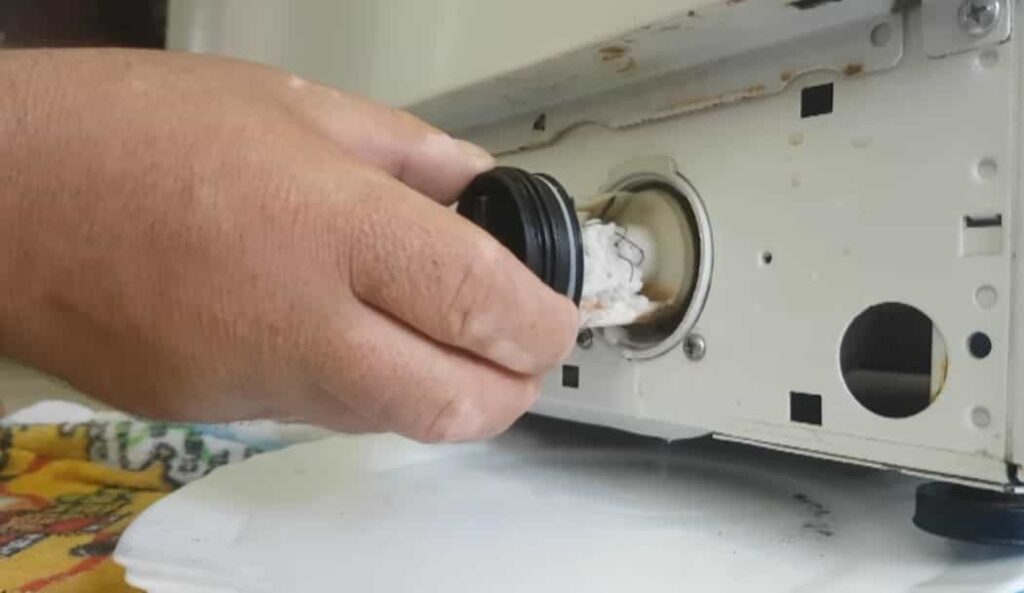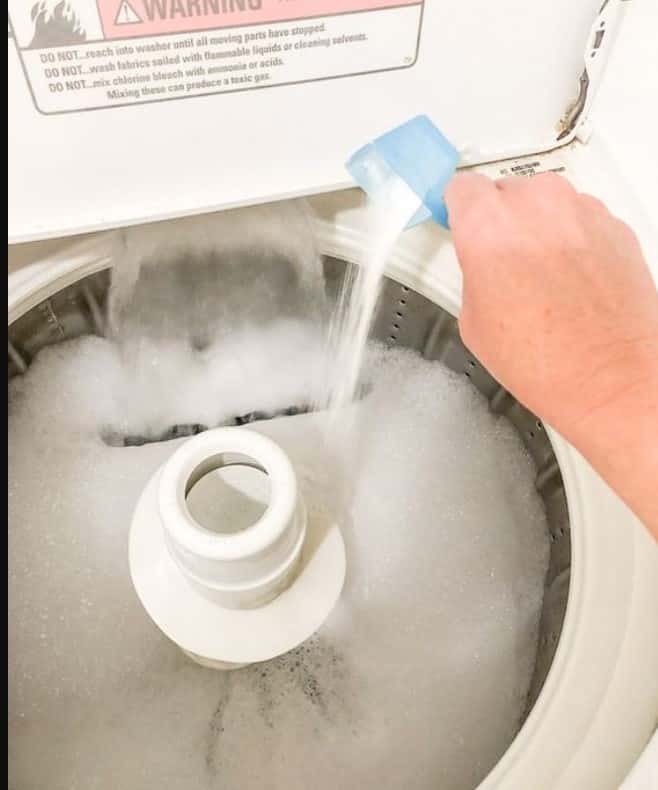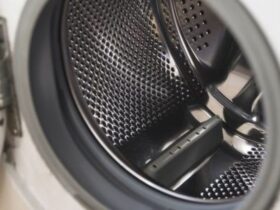It can be frustrating when you notice a leak while using your washer. A washing machine leaking can from the bottom due to several problems. The water inlet valve may be faulty, causing the machine to fill with water during certain cycles. Another reason can be worn or damaged door seals, which can occasionally leak during certain parts of the wash cycle.
One of the most common problems with a washer is a drain hose. Blocked, kinked, damaged or disconnected hoses can cause leaks when you use your washing machine. Inspect the machine thoroughly and refer to your machine’s product manual for instructions on how to troubleshoot a leaking washing machine. You can repair it yourself or take it to a technician to determine. Below we have suggested some tips and tricks on how you can get rid of this problem.

Table of Contents
Can Overloading a Washer Cause It To Leak From The Bottom
In the quest to save time and energy, overloading a washer may seem like a no-brainer. One of the problems that doing this can lead to is your washer leaking from the bottom. This blog post will delve into the complex relationship between washer load capacity and leakage problems, offering practical advice on how to avoid such problems.
Understanding your washer’s load capacity
Manufacturer’s Guide
Every washing machine work has a specific load capacity, usually listed in pounds or kilograms. This capacity represents the optimum amount of laundry that the machine can efficiently handle. Exceeding this limit can create stress on various components. This can eventually lead to leakage.
Symptoms of overloading
It is very important to recognize the symptoms of an overloaded washer:
- Clothes are not moving
- The drum is full to the brim
- The device is making unusual noises or vibrations
- Ignoring these symptoms can lead to more serious problems.

6 Common Causes of Washing Machine Leaking
Washing machines leaking are essential appliances for any household or make laundry tasks more manageable. However, leaks can sometimes become a source of frustration. Understanding the common causes of washing machine leaks is crucial to maintaining the performance and longevity of your machine
Any type of containment failure can occur inside or outside the washing machine. The washer, understandably, has a complex system of tubes and valves that allow it to supply and drain water in the process of cleaning your clothes. So today, we’re going to go through the possible causes of washing machine leaks problem by problem to help you gain some perspective on the problem.
Loose Hose Connections
One of the primary causes of leaking under a washing machine leaking is the hose connection. Over time, the connections between the machine and the water supply hose can loosen, causing water to leak.

That’s why locate the water supply valve located on the wall behind your washing machine. These valves usually resemble two metal taps, a red knob for hot water and a blue one for cold. If you notice any moisture around these taps, this may indicate they are loose from their mounts. A more common problem is usually with the hose connecting the supply valve to your washing machine.
Start by inspecting the hose connection at the wall valve. Then, trace the hose to the back of your washing machine leaking and make sure the connection is firmly secured and leak-free. If you detect any damage to the hose or an incomplete connection between the valve and the washer, you may experience a leak.
Damaged door seals

The door seal, also known as the washing machine gasket, ensures that water stays inside your washing machine during a cycle. If the seal is damaged or worn, it can leak, especially from the bottom of the machine.
Overloading

Overloading your washing machine leaking can cause water to leak out of the drum. If the water does not come out, the washing powder dispenser may overflow.
On the other hand, don’t overstuff your washer with clothes or heavy fabrics. Because this is the most common cause of a washer leak. If you spot a leak, use portable machine on the fastest wash cycle with no clothes and no detergent. If it doesn’t leak, it’s because the machine was simply overloaded.
Clogged Drain Pump
Another possible cause of washing machine leaking is a damaged drain pump. The drain pump is responsible for pumping water out of the washing machine during washing, and if it is clogged or damaged, it can leak. And to solve this problem, you need to clean or replace the drain pump.


Make sure the water supply is turned off and the washing machine is unplugged before attempting to access the drain pump. It is also important to check valves and pumps for visible signs of damage and repair or replace them if necessary. This way, you can prevent the inconveniences associated with a washing machine leak.
Faulty Inlet Valve
The water inlet valve controls the flow of water into your washing machine leaking. If it becomes faulty, it can cause water to leak out of the valve. And it may leak water with leakage from the bottom of the machine.

Symptoms of a faulty water inlet valve are:
- Irregular water flow in the machine during the wash cycle.
- Inconsistent water temperature, resulting in clothes not being cleaned properly.
- Water leaks around the washing machine, especially during the filling process.
- No water entering the machine at all, leading to an inability to start the wash cycle.
Excessive Detergent Use
Using too much detergent can cause excess suds to form, which can cause overflow from the washing machine and leaks onto the floor. This may give the impression that the machine is leaking from below. It also has many effects on the machine. For example:
Excess detergent creates excessive suds, and this suds build-up can overwhelm the washing machine’s ability to rinse properly.
A build-up of suds can clog drain pipes, causing drainage problems. There may even be possible damage to the machine.

Excess detergent residue can build up in various components of the washing machine, such as the drum, hoses and dispenser drawer, which can also lead to mold growth and unpleasant odors.
How Do I Fix a Leaking Washing Machine From The Bottom
In many cases, a leaking washing machine can be solved with simple solutions. This may include tightening hose connections, cleaning door seals, adjusting load sizes, cleaning drain pumps, replacing inlet valves, and reducing detergent usage.
Tighten the hose connection
Check the connections of the water supply hoses on your washing machine leaking to make sure they are securely attached to both the machine and the water supply valve. Use a wrench to tighten loose connections.
Replace damaged hoses
Inspect the hose for any cracks, splits, or signs of wear. If you notice any damage, replace with a new hose. Make sure to use a hose specially designed for the washing machine leaking and follow the instructions.

Clean the filter screen
Many washing machine hoses have filter screens to prevent debris from entering the machine. Remove the hose and thoroughly clean the filter screens with a brush or toothbrush to prevent any leaks and remove blockages.
Inspect the water inlet valve
Check the water inlet valve for any signs of damage. If the valves are defective, they may need to be replaced. Refer to your washing machine’s manual for instructions on accessing and replacing the inlet valve.
Replacing door seals or gaskets
If you have a front-loading washing machine leaking and see water coming out of the door, the seal or gasket around the door may be damaged or worn. Replace the seal or gasket following the manufacturer’s instructions.
Check the drain hose
Inspect the drain hose for any kinks, bends or obstructions that could cause water to leak. Straighten out any kinks and make sure the hose is properly connected to the drain pipe or utility sink.
Clean the detergent dispenser
Detergent dispenser residue can also sometimes leak. Remove the dispenser drawer and clean thoroughly with warm, soapy water. Rinse it thoroughly before reinstalling.
Level the washing machine
Make sure the washing machine leaking is level on the floor. Use a leveling tool to adjust the machine’s feet if necessary.
Inspect the pump
Water leaking from the bottom of the machine can damage the pump. Inspect the pump for any blockages or signs of wear and clean or replace the pump if necessary.
Run a test cycle
After making any repairs or adjustments, run a test cycle with an empty load to check for leaks. Closely monitor the machine during the filling, washing and draining stages to ensure that the problem is resolved.
By following these DIY solutions, you’ll be able to identify and fix the most common causes of washing machine leaking without needing professional help. However, if you are unsure or uncomfortable about a repair, it is always best to consult a qualified technician.
Maintenance Tips To Avoid Washing Machine Leaking
Here are some tough preventative maintenance tips to keep your washing machine leaking in top condition:

Regular inspection:
Make it a habit to inspect your washing machine regularly. So that there are no signs of wear or leakage. Catching potential problems early can prevent them from escalating into bigger problems.
Using the right amount of detergent
Using excess detergent can create excessive suds, which can cause overflow and leakage. Follow the manufacturer’s instructions for the correct detergent amount based on your load size and water volume. Then there will be no more overflow.
Cleaning the washing machine
Detergent residue and build-up of dirt can build up in various parts of the washing machine, including hoses and seals, causing leaks. Clean detergent dispensers, door seals and lint filters regularly to prevent clogs and leaks.
Avoid overloading
Overloading the washing machine leaking puts too much pressure on it. Excessive overloading increases the likelihood of drum bearings and seals leaking. Follow the recommended load capacity specified by the manufacturer to prevent overloading.
Professional Servicing
Schedule periodic professional servicing for your washing machine. So that when you notice any unusual noise, vibration or leak, you can get servicing immediately. A qualified technician can maintain internal component inspections to ensure optimal performance.
If you follow these preventive maintenance methods, you can extend the life of your washing machine. That you can also reduce the risk of leaks, get rid of leaks and can save you time and money in the long run.
Conclusion
Your washing machine leaking can cause a problem for any household. This is not only frustrating, but it can also create potential harm to your machine. However, by understanding the common culprits behind these leaks and taking proactive steps to address them, you can effectively address the issue. Protect both your machine and family from further damage.
Regular maintenance plays an important role in maintaining a leak-free washing machine. This includes periodically inspecting hoses and seals, cleaning the drainage system and choosing the right detergent. By following these maintenance practices, you can ensure smooth operation for your washing machine leaking and extend its lifespan.
If you are unable to resolve this, seeking the help of a professional is the wisest course of action. Trusting experts ensures proper functioning of your washing machine.
Frequently Asked Questions
Why is my washing machine leaving water in the bottom?
A washing machine not draining can have multiple causes, including a clogged or jammed drain hose or a broken pump, lid switch, or belt. No matter the culprit, you need to drain the water from the washing machine before diagnosing the issue or doing any work to remedy the situation.
How to unclog a washing machine drain?
Fill the washing machine with enough water to cover the rubber cup of the plunger. Place the plunger over the drain and push down firmly, creating a seal. Then repeat this process several times. Then remove the plunger and run the washing machine
How to clear a blocked washing machine waste pipe?
Use a funnel to pour about a quarter of a cup of baking soda into the pipe. Then empty a baster with vinegar on the drain hose
Can a leaking washing machine be fixed?
How to fix a leaky washing machine hose Connect the fill and drain hoses securely to your washing machine to prevent leaks. Then check each hose to see if they are properly attached to the machine.
Can I use a leaking washing machine?
It is generally not safe to use or leave water attached to a leaking washing machine. Leaking water can cause more problems for your machine – water will run into parts that aren’t supposed to get wet.












Leave a Reply